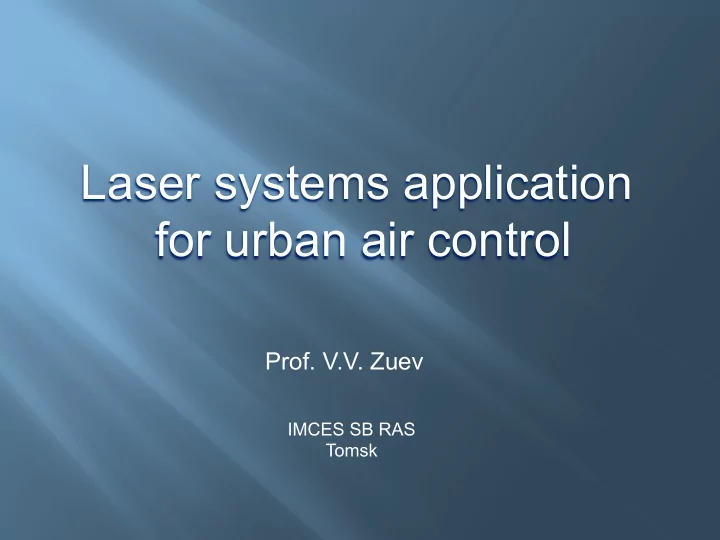

Laser systems application for urban air control Prof. V.V. Zuev IMCES SB RAS Tomsk
Gas absorption bands and atmosphere transparency spectrum sm/mol 1 2 3 4 5 6 7 8 9 10 11 12 13 λ , µ 2
Trace DIAL gas analyzer Mobile gas analyzer version CW-CO2-laser TEA-CO2-laser 3
Table of analyzed gases Emission lines and their combinations MDC, N Gas p р b on-line off-line Main bands of СО 2 - lasers (9 and10 mkm) emission 1 SF 6 10P(16) 10P(10) 8*10 -2 2 N Н 3 9R(30) 9R(28) 1 3 Н 2 О 10R(20) 10R(18) 165*10 +3 4 С 2 Н 4 10P(14) 10P(12) 2 5 О 3 9P(14) 9P(22) 5 Second harmonics and total frequencies of СО 2 - lasers (4,5÷5,4 mkm) 6 NO 2 х 10P(24) 2 х 10P(26) 5 7 CO 2 х 9P(24) 2 x 9P(26) 4 8 OCS 2 x 9P(30) 2 х 9P(14)' 1 9 CO 2 10R(30)+9R(14) 2 x 9P(40) 4*10 +3 10 N 2 O 9R(40)+9R(18) 2 2 х 9R(40) 6 4
Major problems 1. Size and power-consumption minimization 2. Spreading of IR laser emission spectrum lines 3. Absorption spectra interference of various gases
Miniaturization Mini TEA CO 2 laser and a lidar with SHG on its basis
Spreading of IR laser emission spectrum lines Generation range spreading via sequential, hot, double 1. hot , and sequential-hot emission bands Development of gas lasers with СО 2 -lasers pumping 2. Down-conversion into the THz range with frequency 3. tuning
Generation range spreading via sequential and hot emission bands Absorption Wavelength, mkm Hot emission lines position at the wavelength up to 11,4 mkm ( dashed lines) and water absorption lines.
Narrow-band tunable gas lasers with CO2-laser emission optical pumping At optical pumping with TEA CO 2 laser that emits 0111-1110 ( λ ∼ 11.4 µ m) at the hot band the emission in the far IR spectrum range 0001-1200 ( λ ∼ 117 µ m), 0001-2000 (45.6 µ m) and 2000-1110 (38.9 µ m) is generated in the TEA CS 2 laser.
Tunable down-conversion of СО 2 – laser emission lines in non-linear GaSe in the THz spectrum range mkm G FD mkm deg external Down – conversion is possible in the range of 0.4 ≥ 5 THz THz emission signals in the range of 0.5-3 THz at the capacity of a ten kV’s and detectors’ voltage output signals
Allowed spectrum of fluid in the THz spectrum range Abcorption, % sm-1
Gas analysis selectivity growth at gases interference by means of Sub-Doppler spectroscopy off-line on-line Absorption coefficient ω Absorption coefficient ω
Problems 1. The development of super narrow-band lasers for Sub-Doppler spectroscopy 2. СО 2 -laser frequency merging with microwave sources in microwave frequency waveguides ( guided/controlled spectral emission lines shift) by means of electroscopic effect
Super narrow-band СО 2-laser 1. Passive frequency stabilization (a massive resonator quenches high- frequency oscillations) 2. Temperature stabilization Δ Т = ± 1 ° 3. ТЕМ 00 mode selection 7. Slow independent magnetostrictive adjustment of the bearing resonator rods’ length in the range of 0.1-10 mkm (quenches thermal expansion during measurements) 5. Piesoelectrical fixation of a single longitudinal mode to the luminescence line center Δν Δν =2 ⋅ 10 -3 sm -1 6. A single longitudinal mode selection via power supply choice
СО 2 -laser frequency mixing with microwaves in microwave frequency waveguides by means of electrooptic effect Microwave frequency waveguide cross-section with electrooptic crystal CdTe ; tunable СО 2 -laser and tunable magnetotron pumping. Parameters: - The efficiency of 16 GHz – 27% frequency shift; - Frequency tuning via mechanical waveguide nodes (sidewall shift) in the range of 13,9-17 GHz
Gas analysis selectivity growth on long path when gases interference takes place by means of CO2- laser frequency sweeping The advantages of the direct CO2- laser emission merging with microwave radiation: - High sweeping frequency (~ MHz) of the emission wavelength - Possibility to use DAS methods of the first and second derivative - A wide range of mixed radiation detuning up to 1-1,5 sm -1 that is equivalent to continuously tuned emission spectrum with a narrow emission line width and high energy output parameters
Summary As a rule, urban atmospheric conditions with complex gas composite are characterized by the absorption spectra super position that hampers acquisition of selective reliable data on gas concentrations: - One of the ways of gas analysis growth is Sub-Doppler absorption spectra measuring in the absorption cells of low pressure (spectrophones or multi-pass cells) by means of mixed emissions of CO2-laser and microwave emissions in the microwave frequency waveguide. - Another way is to measure on long routes with fast CO2-laser frequency sweeping at the direct merging with the tunable microwave emission. - Certain perspectives of laser control of atmospheric pollution are connected with THz spectrum range analysis.
THANK YOU FOR ATTENTION
Recommend
More recommend